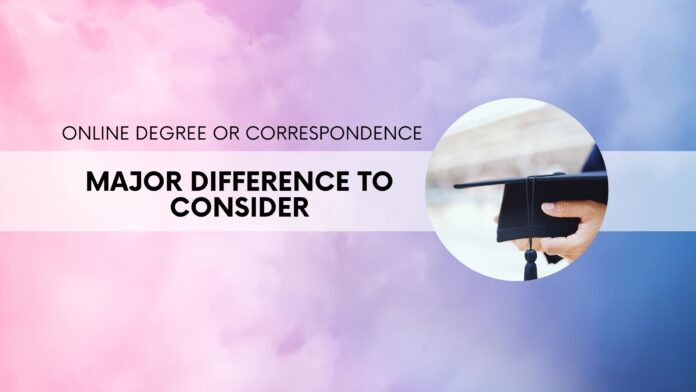Now, learners have different ways to continue their education. With greater flexibility and affordability and without any restrictions, one may pursue their education.
In addition to classroom settings, online education is also popular among students. Nearly half of the population prefers to continue their education in an online learning mode. In an online degree, they have the freedom to take live or recorded classes. Moreover, students also have the freedom to hire online class helpers for timely assistance. By simply searching, can I pay someone to take my online class one may hire professional experts. Whether you need help with statistics or mathematics online classes, you can get help at an affordable price. Professional help is available for all subjects.
Tinywolfbrewing | realmadridweb | topdigitaltv | hkindogames | skysports4u
Correspondence course learning is also as popular as online learning. Both modes of education have many advantages. But there are some disadvantages as well. Students who are planning to further their education should closely consider everything. This will help them in making the right decision. This write-up might be quite helpful for someone who is confused about which learning method to choose and why.
Major Differences Between Both Modes of Education
Traditional classroom learning is not the only option to continue education. Whether you want to continue with online learning or correspondence, you can do so. However, make sure you are aware of the key difference between these two modes of education. The right knowledge will help you make the right decision without any disappointments.
The information below is a detailed explanation of different factors and will help you in making the best choice.
Practical Knowledge
To prepare better for industry roles, it is essential to understand the importance of practical knowledge.
- Online learning students can have better exposure to hands-on training. They can gain better practical exposure, all thanks to the development of technology. Instant feedback will allow students to improve their overall performance. Moreover, live projects are an opportunity to connect with industry partners.
- In correspondence learning, there is limited practical exposure. Students who are going to continue their education via distance learning must be aware of this. You must mostly have to rely on printed study materials and postal communication. There won’t be many opportunities for real-world applications.
Career Opportunities
Students should also consider the career opportunities they will have. It is the most important factor to consider. It is essential to know about the job you will get after completing your education. When choosing online or correspondence education, you must know the outcome.
- Online degrees offer better career opportunities. You may receive as many good job offers as in a traditional setting. As an online degree graduate, you can find employment literally everywhere. Individuals may easily apply for full-time, freelancing, and remote roles.
- Students from correspondence degrees might not have much freedom in education. You might face hurdles as employers don’t widely accept graduates from correspondence learning. You may apply for basic-level corporate jobs, but surviving in a highly competitive market might be difficult.
Pacing Flexibility
Pacing matters a lot in education. It maintains learning momentum and supports different learning styles. It can reduce stress and prepare students to manage deadlines and multitask effectively.
We all know that each student is different from the other. They all have their own learning speed and prefer to complete their course or curriculum according to it. When considering different modes of education, do not forget to pay attention to pacing flexibility. Here is what students need to know about the difference in pacing.
- A correspondence course is the most flexible form of education. Here, students have full freedom in learning, as there is no real-time tracking or regular deadlines. Learners have full flexibility and can manage everything by themselves. However, there is also a drawback. There is a high possibility that students may lose motivation or forget their assignment deadlines. There is no direct support from instructors.
- In online learning, pacing is of different types. Here, the learning is structured with weekly deadlines, but students still have control in self-paced models. There are also time-bound activities like scheduled lectures and discussions. In simple words, students have moderate to high flexibility with proper guidance from professors. Teachers can thoroughly guide and track progress. Regular feedback and interactive support can lower the risk of failing.
Recognition
Here comes the most important factor, which can decide which learning method is the best. Pursuing degrees from an accredited online university should be your top priority. This will improve employer acceptance and increase the chance for global opportunities.
- Online degrees are mostly accredited and widely accepted by top universities. Employers give it equal importance as traditional degrees. They are accepted for higher studies and also by top employers. Online certificate programs are also highly popular for helping in cross-border recognition and career prospects.
- One of the major drawbacks of distance learning is that it does not meet the requirements for professional licensing support. They are also considered to be outdated and are not widely recognised.
Instructor Support
Having a good support from teachers is a necessary factor to consider. Students who don’t receive support often struggle to continue with their learning. This can impact the overall academic performance. Many of them eventually start asking, can I pay someone to do my online exam to get the academic success they deserve? Being handled by qualified experts makes the academic journey easier.
Whether you choose online learning or correspondence, you must receive the best support from instructors.
- In distance learning, there is scope for only limited interaction. Here, there is no direct interaction with instructors. Correspondence education offers minimal communication with faculty.
- On the other hand, online degrees are more interactive. Here, students have the opportunity to directly interact and communicate in online classes. There are more opportunities for frequent interactions.
Financial Aid
Students should not forget to compare the financial aid of these two methods of learning. Check whether your chosen method supports various financial aid options or not. This way, you can align your interests and requirements in a combined manner.
- Online learning methods are more affordable than traditional learning systems. Moreover, it covers different financial aid to make learning more affordable for students. From scholarships to grants to employer sponsorship, different funding opportunities are available in online learning mode. However, students are advised to thoroughly verify the online programs from recognized institutions to qualify for financial aid.
- Correspondence learning is more affordable than other methods. However, there is not much financial aid available here. No federal or MOOC support is available, and students are required to make a one-time payment. Though the tuition fee is low, employer support and governmental aid are rarely applicable over here.
Examination Method
The way of conducting examinations is also different in online learning and correspondence learning. Before making any decision, be aware of how exams are being conducted.
- Different types of exam formats are there in the online education system. Online proctored exams, time-based tests, and open books are to name a few. There are other formats like autograded quizzes and timed assessments. The best part of continuing education online is that you will have the freedom to ask for help. Students no longer have to wonder, can I pay someone to take my online exam? In overwhelming situations, they can easily hire online exam helpers to assist them.
- Manual investigation can be tough. In correspondence learning, exams are paper-based. Examinations are mostly conducted at physical examination centers with strict supervision methods.
Aajkalkikhabar | realtechgadget | doodleartsltd | soundsupportva | starlovebuzz
International Value
When deciding on an online or correspondence course, you must also consider the international value of these degrees. A strong international value opens doors to global opportunities. If you are planning to apply for overseas jobs, you must know which mode of education will help you achieve it.
- Online degrees help in international recognition, as they are widely accepted. Online degrees from reputed universities are aligned with global educational standards. They have better employee perception and are viewed positively.
- Correspondence degrees have limited global recognition. They are not typically recognized and may raise concerns, especially if not accredited by international bodies.
Final Words
In addition to all the factors listed above, consider looking at the universities and the courses they offer to make the right decision. Choosing a learning format can be confusing, especially for beginners. There are many things one should consider to make the right decision. To everyone wondering which is the most suitable for me, there is no proper answer for it. Each learning format has its barriers and strengths. One must consider everything, like goals and career outcomes, before choosing one.
Some find online learning to be convenient while others may not. It all depends on what you want and what your goals are. Online learning can be most suitable for working professionals and tech-savvy learners. On the other hand, correspondence learning is suitable for independent learners or students with limited access to education. It is also ideal for those with financial constraints. Anyone who wants to learn subjects like literature, philosophy, and history can proceed with correspondence learning easily. There are many other subjects that you can comfortably learn via distance learning. It is all upto you on you on how you proceed with the curriculum learning.




